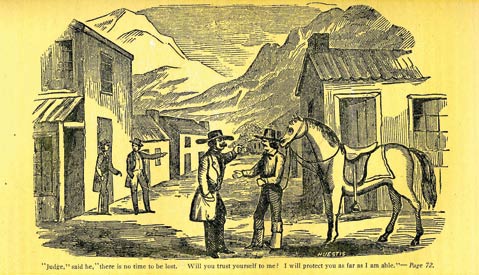Who Was Ned McGowan?
Fugitive from S.F. Hides in S.B.

In the mid 1850s, San Francisco was in chaos. The corrupt city government found itself near bankruptcy. Disgust over political affairs was at an all-time high. The city’s newspapers targeted public figures for scathing attacks. One of the most intemperate editors was twice-failed former banker James King of William of the Evening Bulletin. His attacks on city officials were personal and not always backed by a close attention to facts.
Nonetheless, he found that a crusading zeal for reform, coupled with vitriolic editorials, was great for business. In the spring of 1856, King zeroed in on James Casey, a city councilmember and editor of a rival newspaper. King challenged the legitimacy of Casey’s election and publicized Casey’s prison time for beating and stealing from his mistress. On May 14, Casey confronted King on the street and shot him through the chest. This incident sparked the formation of the Second Vigilance Committee. Within 24 hours, the vigilantes controlled the city and would for the next three months. The committee hanged Casey on May 22.
The committee began cleaning up the town, banishing more than 500 from the city under threat of death should they return. One of these was Edward “Ned” McGowan. A close friend of Casey, rumor now spread that he had supplied the firearm that killed King. Fearing the noose, McGowan fled south and reached Santa Barbara in July.
McGowan was having dinner in a hotel near De la Guerra Plaza when he was recognized by Albert Packard, a former San Francisco resident. Sheriff James Russel Heath was summoned, but coming to McGowan’s aid was the infamous bandit Jack Powers, who had made McGowan’s acquaintance in San Francisco several years before.
Powers hustled McGowan into the Casa de la Guerra, across the street from the hotel, and according to one report hid him under a large canvas or a pile of dirty clothes. A large crowd gathered outside, keen on capturing this notorious refugee. Powers directed the crowd to the De la Guerra Gardens, centered on Garden and Cota streets. Convinced its prey was cornered, the crowd fired a field of tules to smoke McGowan out and was most disappointed when this had no result.
Heath now led a search of the town, coming eventually to the Casa de la Guerra. McGowan had emerged from his hiding place and stationed himself near the door, gun drawn. Again, Powers steered the search party away. Shortly after, McGowan made his way to the hills behind the city.
McGowan spent quite some time in Santa Barbara County. His Narrative of Edward McGowan, published in 1857, contains marvelous descriptions, not only of the city, but also of some of the surrounding ranchos, including Nicholas Den’s Rancho Los Dos Pueblos in the Goleta Valley and Rancho Refugio of the Ortega family. He continued to lay low as representatives of the Vigilance Committee visited Santa Barbara in search of him.
Eventually McGowan was brought to trial, in Napa in Northern California, and was acquitted. His Narrative remains a most valuable portrait of Santa Barbara in the 1850s.



